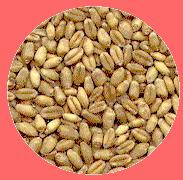Wheat is an ancient grain. Thought to have originated in southwestern  Asia, it has been consumed as a food for more than 12,000 years.
Asia, it has been consumed as a food for more than 12,000 years.
It played an important role of religious significance and was part of the sacred rituals of many cultures. Greek, Roman, Sumerian and Finnish mythology had gods and goddesses of wheat. This exceptionally nutritious grain is still considered to be sacred in some areas of China.
 Asia, it has been consumed as a food for more than 12,000 years.
Asia, it has been consumed as a food for more than 12,000 years.It played an important role of religious significance and was part of the sacred rituals of many cultures. Greek, Roman, Sumerian and Finnish mythology had gods and goddesses of wheat. This exceptionally nutritious grain is still considered to be sacred in some areas of China.
Wheat was not native to the Western Hemisphere and was only introduced here in the late 15th century when Columbus came to the New World. While wheat was grown in the United States during the early colonial years, it was not until the late 19th century that wheat cultivation flourished, owing to the importation of an especially hardy strain of wheat known as Turkey red wheat, which was brought over by Russian immigrants who settled in Kansas.

As rice has been the dietary staple of Asia, wheat has served this role for many of other regions of the world. It is estimated that approximately one-third of the world's people depend upon wheat for their nourishment.
The collection of wheat offered man a number of advantages. Grains could be stored without spoiling. They could be stocked or carried from place to place and prepared in any number of ways. Grain could be traded for
 other essentials or comforts, eventually leading to the development of commerce and a means of supplying food for city populations from distant fields.
other essentials or comforts, eventually leading to the development of commerce and a means of supplying food for city populations from distant fields.Today, the largest commercial producers of wheat include the Russian Federation, the United States, China, India, France and Canada.
Food History


